Introduction to JSP Interview Questions
Java Server Pages (JSP) technology is a server-side programming language that is used to build a dynamic web page in the form of HyperText Markup Language (HTML). It is a development of servlet technology.
Internally, a JSP page is transformed into a servlet. JSP offers access to the whole Java API family, including the JDBC API for accessing business databases. As a result, Java language syntax is employed in the java server pages (JSP). JSP pages are easier to maintain than Servlet pages because we can separate design and development. It has certain extra features such as Expression Language, Custom Tags, and so on.
In this article on (Java Server Pages) JSP Interview Questions. We’ll go over the most common JSP Interview Questions.
JSP Interview questions for freshers:
What is JSP?
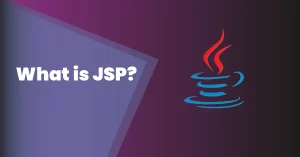
In this JSP interview questions blog, it is an abbreviation for Java Server Pages. This technique is used to generate dynamic web pages using HyperText Markup Language (HTML). They contain Java code encoded in them.
They are a Servlet Technology extension that generates Servlets from a page. It is typical to employ servlets as well as JSP pages in the same web project. This is one the basic JSP Interview Questions that the interviewer asks.
How does JSP function?
The page compiler is a specific servlet in the JSP container. The configuration of the servlet container forwards all HTTP requests with URLs that match the.jsp file extension to this page compiler. This page compiler converts the servlet container into a JSP container. When a.jsp page is called for the first time, the page compiler parses and compiles it into a servlet class.
After a successful compilation, the JSP servlet class is loaded into memory.
After a successful compilation, the JSP servlet class is loaded into memory. The servlet class for that .jsp page is already in memory for subsequent calls. As a result, the page compiler servlet will always match the JSP servlet’s timestamp to the JSP page’s timestamp. If the .jsp page is more recent, recompilation is required. Once deployed, JSP pages only have to go through the time-consuming compilation procedure once. The interviewer can ask you these JSP Interview questions to test your knowledge of the JSP function.
What are the JSP life-cycle methods?
|
Method |
Description |
|
public void jspInit() |
It is invoked only once, the same as the init method of the servlet. |
|
public void _jspService(ServletRequest request,ServletResponse)throws ServletException,IOException |
It is invoked at each request, same as the service() method of the servlet. |
|
public void jspDestroy() |
It is invoked only once, the same as the destroy() method of the servlet. |
The interviewer can ask you these JSP Interview questions to test your knowledge of the JSP life cycle.
List some of the benefits of using JSP.
Benefits of using JSP:
- Improved performance.
- JSP is compiled before it is handled by the server, eliminating the need to load the interpreter and code script each time.
- JSP has access to all-powerful corporations.
- JSP is simple to handle since we can simply isolate our business logic from our display logic. We combine business logic and display logic in Servlet technology.
- JSP may also work in tandem with servlets.
The interviewer can ask you these JSP Interview questions to test your knowledge of the benefits of JSP.
What is the use of JSP?
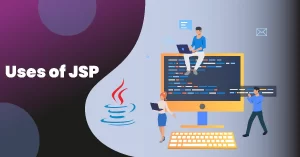
Previously, the sole tool for producing dynamic web content was Common Gateway Interface (CGI), which was inefficient. For each request, the webserver must launch a new operating system process, load an interpreter and a script, run the script, and then break everything down again.
This is demanding on the server and does not scale well as traffic grows.
Alternatives such as Microsoft’s ISAPI and Sun Microsystems’ Java Servlets provide higher performance and scalability. They build web pages, however, by directly embedding HTML in computer language code. JavaServer Pages (JSP) alters everything. The interviewer can ask you these JSP Interview questions to test your knowledge of the use of JSP.
What exactly are Java Server Template Engines?
A Java servlet template engine is a technology that allows you to separate presentation from processing. To assist in getting HTML out of servlets, template engines have been developed as open-source technologies.
These template engines are designed to be used in conjunction with pure code components (servlets) and rely solely on web pages containing scripting code for display. The interviewer can ask you these JSP Interview questions to test your knowledge of Java Server Template Engines.
What is the distinction between a hidden comment and an output comment?
The JSP comment is known as the hidden comment, whereas the HTML comment is known as the output comment. When a user examines the page’s source code, the JSP comment is hidden, however, the HTML comment is visible. The interviewer can ask you these JSP Interview questions to test your knowledge of the distinction between a hidden comment and an output comment.
What specifically are Servlets?
In the same application, JSP pages are frequently paired with servlets. The Java servlet standard serves as the foundation for the JSP specification. Simply described, a servlet is a piece of code that, like CGI and proprietary server extensions like NSAPI and ISAPI, offers additional capabilities to a web server. Servlets offer several benefits over other technologies:
- Platform and vendor independence
- Integration
- Efficiency
- Scalability
- Robustness and security.
The interviewer can ask you these JSP Interview questions to test your knowledge of servlets.
Explain the Life Cycle of a servlet.
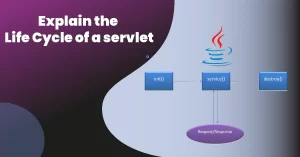
A Servlet is a Java class that implements the Servlet Application Programming Interface (API). The Servlet API is made up of several classes and interfaces that specify various functions. These techniques allow you to process HTTP requests in a way that is independent of the webserver.
When a web server receives a request that should be handled by a servlet, it loads it. Once a servlet has been loaded, subsequent requests are handled by the same servlet instance (object). The web server must eventually shut down the servlet, usually when the webserver is shut off.
The three life cycle techniques are as follows:
- public void init(ServletConfig config)
- public void service(ServletRequest req, ServletResponse res)
- public void destroy( )
The interviewer can ask you these JSP Interview questions to test your knowledge of the life cycle of the servlet.
Is JSP technology scalable?
Yes, JSP technology may be extended by creating new actions, or tags, which are encased in tag libraries. The interviewer can ask you these JSP Interview questions to test your knowledge of JSP technology.
JSP Interview questions for Intermediate level:
How does JSP fit within the MVC model?
JSP is comm
only used for presentation in the MVC paradigm (Model View Controller), in which it serves as the view. The controller is in charge of calling the model and the business classes, which in turn get the data, which is then supplied to the JSP for displaying on the client. The interviewer can ask you these JSP Interview questions to test your knowledge of the MVC model.
What exactly is the JSP Expression Language (EL)?
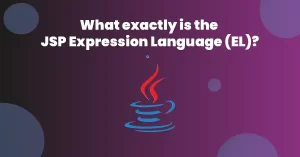
JSP 2.0 added Expression Language (EL). It is a method that makes data held in Javabean components and other objects such as requests, sessions, and applications more accessible. There are several operators in JSP that are utilized in EL to perform an expression, such as arithmetic and logical operators. The interviewer can ask you these JSP Interview questions to test your knowledge of expression language.
What precisely are JSP Operators?
Within expression language (EL) tags, JSP Operators provide the majority of the arithmetic and logical operators supplied by Java.
|
. |
Access a bean property or Map entry. |
|
[] |
Access an array or List element |
|
() |
Group a subexpression to change the evaluation order. |
|
+ |
Addition |
|
– |
Subtraction or negation of a value |
|
* |
Multiplication |
|
/ or div |
Division |
|
% or mod |
Modulo (remainder) |
|
== or eq |
Test for equality |
|
!= or ne |
Test for inequality |
|
< or lt |
Test for less than |
|
> or gt |
Test for greater than |
|
<= or le |
Test for less than or equal |
|
>= or ge |
Test for greater than or equal |
|
&& or and |
Test for logical AND |
|
|| or or |
Test for logical OR |
|
! or not |
Unary Boolean complement |
|
Empty |
Test for empty variable values. |
The interviewer can ask you these JSP Interview questions to test your knowledge of operators.
Describe the JSP for a loop.
The JSP For loop is used to iterate through the items based on a criterion, and it contains three parameters:
- The variable counter is set to zero.
- The condition must be met till the loop is run.
- The counter must be increased.
The for loop syntax is as follows:
for(inti=0;i<n;i++)
{
//block of statements
}
The interviewer can ask you these JSP Interview questions to test your knowledge of JSP for a loop.
Demonstrate the JSP while loop.
The JSP While loop is used to cycle through the items when the condition has one argument.
While loop syntax:
While(i<n)
{
//Block of statements
}
The interviewer can ask you these JSP Interview questions to test your knowledge of JSP while loop.
Is it possible to utilize the implicit exception object on any JSP page?
No, An exception implicit object may only be used on the error page, which is defined by the page directive’s is ErrorPage property. The interviewer can ask you these JSP Interview questions to test your knowledge of implicit exception objects.
How does JSP fit within the MVC model?
JSP is commonly used for presentation in the MVC paradigm (Model View Controller), in which it serves as the view. The controller is in charge of calling the model and the business classes, which in turn get the data, which is then supplied to the JSP for displaying on the client. The interviewer can ask you these JSP Interview questions to test your knowledge of the MVC model.
What has taken JSP’s place?
Separate client-side modules developed in Angular, React, or Vue, on the other hand, replaces JSP. UI and server-side logic, which was formerly combined into a single codebase, are now separated into different codebases. The interviewer can ask you these JSP Interview questions to test your knowledge of JSP trends.
Is JSP still being used?
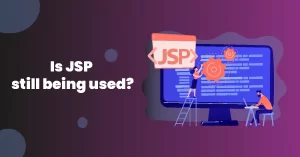
Servlets and JSPs are considered obsolete technologies and are no longer used in new projects. These were discovered to be widely used in legacy projects. Around the year 2000, servlet JSPs were widely utilized. With the growing popularity of new MVC frameworks such as Struts, Webwork, Spring, and others. The interviewer can ask you these JSP Interview questions to test your knowledge of the latest trends of JSP.
Is JSP used as a front end or a backend?
While JSP is frequently used as a frontend for older JSF applications, Facelets is the recommended view technology for newer JSF implementations. While JSP might not be your first option for creating dynamic web pages, it is an essential Java web technology.
JSP Interview questions for advanced level:
In JSP, how do cookies get set?
The steps for setting cookies using JSP are as follows:
- Creating a Cookie object entails the following steps: Cookie function Object() { [native code] } is called with two strings: a cookie name and a cookie value.
- Changing the maximum age: setMaxAge is used to determine how long the cookie should be valid (in seconds).
- Response.add is used to send the cookie into the HTTP response headers.
- A cookie is a type of cookie that is used to add cookies to the HTTP response header.
The interviewer can ask you these JSP Interview questions to test your knowledge of cookies in JSP.
What is the procedure for deleting the Session Data?
The processes for deleting the Session Data are as follows:-
- Remove the following attribute: public void To erase the value associated with a certain key, the removeAttribute(String name) method is used.
- Delete the entire session: the public void invalidate() function is used to delete the entire session.
- Setting the Session timeout: To set the timeout for a single session, use the public void setMaxInactiveInterval(int interval) function.
- Log the user out: The logout command is used to log the client out of the Web server and invalidate all of the users’ sessions.
- Configuration of the web.xml file in Tomcat: Using the above-mentioned methods, one can set the session timeout in the web.xml file as follows.
The interviewer can ask you these JSP Interview questions to test your knowledge of se
ssion data.
In JSP, how do you erase a cookie?
To delete a cookie in JSP, use the following code snippet.
|
Cookie mycookie = new Cookie(“name”,”value”); response.addCookie(mycookie); Cookie killcookie = new Cookie(“mycookie”,”value”); killcookie . set MaxAge ( 0 ); killcookie . set Path (” / “); killcookie . addCookie ( killcookie 1 ); |
The interviewer can ask you these JSP Interview questions to test your knowledge of cookies.
Why should you use JSP pages to create a web-based client programme?
JSP is the primary language for developing web-based client programmes. Because applets do not require any plug-ins or security policy files on the client systems, whereas applets do. JSP pages also allow for a cleaner and more modular application design by separating application code from web page design. This means that web page designers do not need to know the syntax of the Java programming language in order to do their work. The interviewer can ask you these JSP Interview questions to test your knowledge of JSP pages.
Overview of the Translation Phase
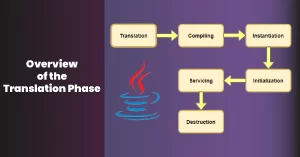
The JSP engine translates and compiles a JSP file into a servlet during the Translation Phase. The execution phase of this servlet is when all requests and answers are handled. For the first time, they are compiled. Unless they are manually compiled, they are not accessible. For long and complicated programs, the manual/explicit compilation is useful. The interviewer can ask you these JSP Interview questions to test your knowledge of the translation phase.
Can you describe the MVC model and how JSP fits into it?
MVC, or Model View Controller, is a design pattern that divides data, business logic, and presentation logic. Model is the application’s state that represents business logic, Controller is the view’s middle element, and model contains data, whilst View is the user interface or presentation layer.
The request is issued from the client machine’s browser via the user interface or presentation layer of the JSP page. The JSP page links to a JavaBean that contains business logic and uses the HTTP protocol to exchange requests and responses. The status information and response content are delivered back to the browser in the response. The interviewer can ask you these questions to test your knowledge of the MVC model and JSP.
What are JSP’s implicit Objects?
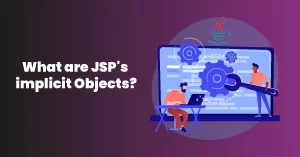
This is an interview question that is based on facts. What it looks for is how much JSP coding you perform on a regular basis; if you do it frequently, you should be familiar with them. The implicit object is a type of object that a web container creates and makes available to a developer via JavaBeans and Servlets. Since they are automatically instantiated, these objects are referred to as implicit objects. They are available by default on JSP pages. The interviewer can ask you these questions to test your knowledge of JSP’s implicit objects.
How can you send information from one JSP to another including JSP?
This JSP interview question is fact-based and a little tough. We can transmit parameters from the main JSP to the included JSP page using the Jsp: param> tag. The interviewer can ask you these questions to test your knowledge of JSP basics.
What is the part of owning a tag library?
A custom tag library is indeed a set of tags created by Ans. Custom actions make it easier to handle recurring tasks, as they may be utilized across multiple applications and boost productivity. Web application designers utilize JSP tag libraries so they may focus on display rather than worrying about how to access databases as well as other enterprise services. Apache presentation tag library and String tag library are two common tag libraries. The interviewer can ask you these questions to test your knowledge of the tag library.
Conclusion
The client-server framework uses Java server pages to assist develop dynamic online content by processing user input data requests and providing HTTP replies. For processing user data, JSP pages use implicit objects, directives, custom tags, and scripts, as well as methods like getParameter(String name) and getParameterValues() to obtain multiple values from the form.
The Java 2 Enterprise Edition (J2EE) simplifies the process of establishing an online presence by allowing developers to design multi-tier, server-side applications using Java. Sun Microsystems released a new component to their Enterprise Java toolkit, named JavaServer Pages, in late 1999. (JSP). The JSP, which is built on top of Java servlets, is intended to speed up the creation of online content by programmers and even non-programmers.
JavaServer Pages aids in the creation of dynamically generated web pages. A JSP page’s content can be changed based on any number of variables. A JSP page has both normal markup language components and unique JSP elements that allow the server to introduce dynamic material into the page, similar to a typical web page. The use of a combination of standard and bespoke elements allows for the building of robust web applications. I hope this article would be helpful regarding JSP Interview Questions.
Frequently Asked Question’s
1. Why is JSP basically used today?
JSP is applied in the creation of dynamic online content. JSP tags are used to insert JAVA code into HTML pages in this example. It’s a more sophisticated version of Servlet Technology. It’s a web-based technology that allows us to make dynamic, platform-independent web pages. JSP is a little bit behind the times.
There are some drawbacks to it as well. JSP, for example, is a major pain in the neck for web designers. Designers can’t simply open a JSP file, make changes, and view the results in the browser since the JSP file contains tags that aren’t valid for HTML. Let’s move on to the next faq for the JSP Interview Questions Blog.
2. Which is faster, JSP or servlet?
JSP is slower than Servlet. JSP is slower than Servlet because it must first be translated into Java code before it can be compiled. Modification in Servlet takes a long time because it requires reloading, recompiling, and restarting the server every time we make a change in our code.
If there is more data processing to be done, a servlet should be utilized, but a JSP should be used when there is less data processing to be done. Servlets are faster than JSP, although JSP is slower than servlets because it requires time to compile and convert the software into servlets. Let’s move on to the next faq for the JSP Interview Questions Blog.
3. Which method is used for JSP?
The getParameter() method in JSP is used to read simple parameters, whereas the getInputStream() method is used to read binary input streams from the client. Let’s move on to the next faq for the JSP Interview Questions Blog.
4. What is the full form of JSP?
Java Server Pages (JSP) is a server-side programming language that allows developers to create dynamic, platform-independent Web applications. JSPs have access to the whole Java API family, including the JDBC API, which allows them to connect to business databases.
This article will show you how to create web apps using Java Server Pages in simple and easy stages. Let’s move on to the next faq for the JSP Interview Questions Blog.
5. What are the roles of JSP directives in client server side programming?
JSP directives are messages that are sent to the JSP container. They provide plenty of information about a JSP page as a whole.
JSP directives are used to offer a container special instructions for converting JSP to servlet code. The translation phase of the JSP life cycle involves converting JSP to a servlet. Let’s move on to the next faq for the JSP Interview Questions Blog.
Separate client-side modules created in Angular, React, or Vue replaces JSP. UI and server-side logic, which was formerly merged into a single codebase, are now separated into two different codebases. Let’s move on to the next faq for the JSP Interview Questions Blog.
7. What are the disadvantages of JSP?
JSP’s disadvantages:
- Since JSP pages are translated to servlets, tracing errors in JSP pages is difficult.
- Because JSP output is HTML, it is limited in terms of functionalities.
- Because JSP pages are initially translated into servlets before being compiled, debugging and tracing issues are extremely difficult.
- It’s not straightforward to join databases.
Let’s move on to the next faq for the JSP Interview Questions Blog.
8. How many tags are there in JSP?
Tags are a crucial component of JSP. JSP tags are divided into four categories.
- Directive tag
- Declaration tag
- Scriptlet tag
- Expression tag
Definitions are as follows:
- Directive tag: This tag is being used to import modules into the currently running JSP application. This directive can also be used to establish error handling pages and session information.
- Declaration tag: The declaration tag is used to declare variables or methods that will be utilized in the JSP’s Java code.
- Scriptlet tag: This tag contains the real java code, such as java declarations, methods, expressions, and so on.
- Expression tag: An expression that has to be evaluated is contained in the expression tag. Any expression that really is valid in Java code can be used in it.
Let’s move on to the next faq for the JSP Interview Questions Blog.
9. When a JSP is executed what is sent to the client?
The JSP engine converts the servlet into an executable class and sends the request to the servlet engine. The servlet engine is a component of the web server that loads and executes the Servlet class. During running, the servlet generates an HTML output. Let’s move on to the next faq for the JSP Interview Questions Blog.
10. How are JSP pages handled?
In JSP, there are two ways to handle exceptions. They are as follows: The page directive’s errorPage and isErrorPage properties. The web’s error-page> element.
When a request is mapped to a JSP page, the web container checks to see if the servlet for the JSP page is older than the JSP page. The web container converts the JSP page into a servlet class and compiles it if the servlet is older. Let’s move on to the next faq for the JSP Interview Questions Blog.
11. What is error handling and debugging in JSP?
Error handling in JSP– The reaction and recovery methods from erroneous situations contained in a software program are referred to as error handling. To put it another way, it’s the process of anticipating, detecting, and resolving application, programming, and communication issues.
Debugging in JSP is the process of tracing an application’s error. It is difficult to track down faults and errors in the program. Client-interactive JSP apps. As a result, faults are difficult to replicate. Let’s move on to the next faq for the JSP Interview Questions Blog.
12. How can you pass information from one JSP to included JSP?
If your application accepts user input, the <jsp:include> tag allows you to give parameters to the include file. In this case, the server uses the request to obtain the form values. The <jsp:param> tags are written using the getParameter() function.













